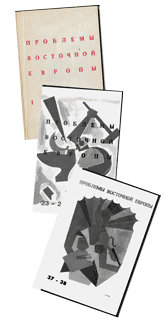For more information, contact Dr. Svetlana Savranskaya, 202/994-7000 or nsarchiv@gwu.edu
 |
| The dissident journal "Problems of Eastern Europe" was published throughout the 1980s |
|
Washington D.C., April 30, 2010 - A rare complete series of the historic dissident journal “Problems of Eastern Europe” achieved its first-ever online publication today as part of the new Russian-language Web pages of the National Security Archive (www.nsarchive.org), also featuring hundreds of digitized facsimiles of declassified Soviet-era documents on topics such as the Cuban Missile Crisis, the Soviet war in Afghanistan, Mikhail Gorbachev and the end of the Cold War, and dissident movements in the Soviet Union and Eastern Europe.
Introduced on the Archive site by long-time editors Larisa and Frantisek Silnicky, “Problems of Eastern Europe” published throughout the 1980s a wide range of Soviet, Eastern European, and ultimately even Western reformist thinking, in order to make connections between those various publics and overcome the information barriers that especially hindered the development of dissident and oppositionist ideas.
The new Russian-language Web pages, compiled and edited by the Archive’s director of Russia Programs, Svetlana Savranskaya, together with technical editor Rinat Bikineyev, also include the most sought-after primary sources in Russian from the Archive’s extensive collections, ranging from the diary of top Gorbachev aide and long-time Central Committee official Anatoly Chernyaev, to the scholarly collection compiled by the late Sergo Mikoyan based on his father Anastas Mikoyan’s experience as a leading Soviet Politburo member, to the specialized collections developed by Archive staff on such topics as the Soviet side of the Cuban Missile Crisis, the Soviet invasion and occupation and withdrawal from Afghanistan, and the surveillance and repression of dissidents such as the Moscow Helsinki Group.
The site also features a new “document of the month,” the original “sovershenno sekretno” (top secret) excerpt of the Soviet Politburo discussion 30 years ago of the Afghanistan war, with an expert report that reads in parts as if lifted from current international debates over progress or the lack thereof in the current U.S. and NATO intervention in Afghanistan.
Today’s publication of primary sources in their original Russian fulfills one of the major goals of the Archive’s Russia and Eurasia Programs, which is to increase public and scholarly access to original sources especially to younger scholars throughout the former Soviet space. In recent weeks, the Russian government has posted online the declassified archive of Soviet documents related to the Katyn massacre of Polish officers by Stalin’s NKVD, Russian President Dmitri Medvedev has endorsed the opening of archives from the Soviet period, and noted Russian expert Dmitri Trenin has called for archival openings as part of a new Russian foreign policy emphasis on cooperative security.
English-language publications of the Archive’s Russia and Eurasia Programs include more than two dozen Electronic Briefing Books of key U.S. and Soviet documents (in translation) covering major Cold war topics and events such as the series of superpower summits featuring Presidents Reagan and Bush with Soviet general secretary Gorbachev, as well as the new book from Central European University Press, Masterpieces of History: The Peaceful End of the Cold War in Europe, 1989, edited by Svetlana Savranskaya, Thomas Blanton and Vladislav Zubok.
Editors' Introduction
Dear readers:
 |
Larisa and Frantisek Silnicky |
|
The journal "Problems of Eastern Europe" (PEE) was intended to help its readers to follow the development of political and economic thinking as well as political and economic experience of East European countries and nationalities in the USSR.
Nationalities and the states of this region differed from one another, but at the same time during the first ten years of the publication of the PEE (it began in 1981) there were similar political and economic structures created in the countries of Eastern Europe according to the Soviet model. As a consequence, most of the problems experienced by those countries were also similar to the Soviet problems.
One of the most serious among those problems was the absence of knowledge among the citizens of East European countries and the USSR of the thinking and steps taken by their neighbors in an attempt to reform their Soviet type systems. We tried to alleviate this problem. This journal played a role of a connecting medium between dissidents and liberal thinkers of the Soviet Union and Eastern Europe.
We also thought that publishing this journal in Russian would help our Western colleagues because some of them who knew Russian did not know the languages of Eastern European states.
With the beginning of "Perestroika" the goal of "Problems of Eastern Europe" changed somewhat. Responding to the demand from the Soviet reformers, we began to reshape PEE as an "ABC of Democracy". We hope that the new content of the magazine proved to be useful.
We are very proud that from now on you will be able to find "Problems of Eastern Europe" on the Internet accessible to future generations of historians, politicians and interested public in Russia, Eastern Europe and the United States. For this we thank the National Security Archive and especially our young and talented friends Svetlana Savranskaya and Tom Blanton.
We are also grateful to the Publisher of the first six issues of PEE Valerij Chalidze, to Radio Liberty, whose New York bureau library facilitated our editing job, to the late Boris Shragin and always young Ludmilla Alexeyeva. They worked with us at the time when we published PEE without any financial help.
Finally, we thank the National Endowment for Democracy whose grants supported PEE from 1985.
We hope that the articles and documents published in PEE will be of interest to our readers of today.
Larisa and Frantisek Silnicky

